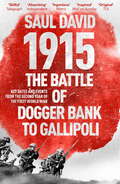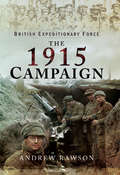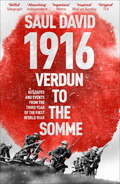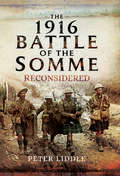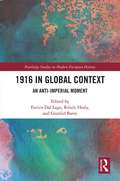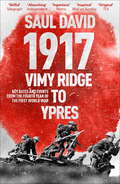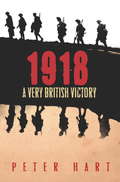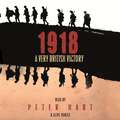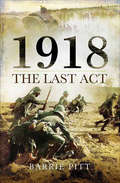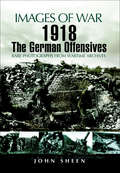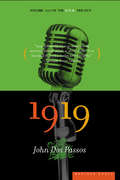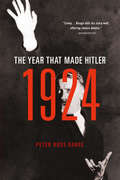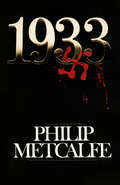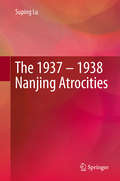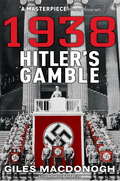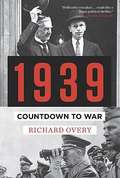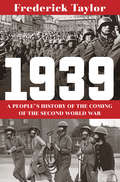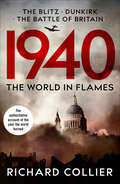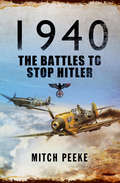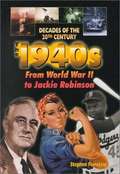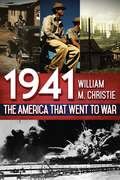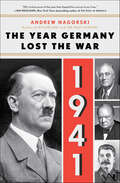- Table View
- List View
1915: The Battle of Dogger Bank to Gallipoli
by Saul DavidThis special ebook has been created by historian Saul David from his acclaimed work 100 Days to Vistory: How the Great War was Fought and Won, which was described by the Mail on Sunday as 'Inspired' and by Charles Spencer as 'A work of great originality and insight'. Through key dates from the Battle of Dogger Bank on 24th January 1914, to the Gallipoli landings, Saul David's gripping narrative is an enthralling tribute to a generation of men and women whose sacrifice should never be forgotten.
The 1915 Campaign: The 1915 Campaign (British Expeditionary Force)
by Andrew RawsonThe British Expeditionary Force The 1915 Campaign is a thorough account of the BEF's actions during the battles of 1915 and early 1916, starting with the success at Neuve Chapelle in March and the nightmare gas attack at Ypres in April. It follows their
1916: Key Dates and Events from the Third Year of the First World War
by Saul DavidThis special ebook has been created by historian Saul David from his acclaimed work 100 Days to Victory: How the Great War was Fought and Won, which was described by the Mail on Sunday as 'Inspired' and by Charles Spencer as 'A work of great originality and insight'. Through key dates from the introduction of conscription in Britain on 27 January 1916, to the first day of the Somme on 1 July 1916, Saul David's gripping narrative is an enthralling tribute to a generation of men and women whose sacrifice should never be forgotten.
1916: Verdun to the Somme
by Saul DavidThis special ebook has been created by historian Saul David from his acclaimed work 100 Days to Victory: How the Great War was Fought and Won, which was described by the Mail on Sunday as 'Inspired' and by Charles Spencer as 'A work of great originality and insight'. Through key dates from the introduction of conscription in Britain on 27 January 1916, to the first day of the Somme on 1 July 1916, Saul David's gripping narrative is an enthralling tribute to a generation of men and women whose sacrifice should never be forgotten.
The 1916 Battle of the Somme Reconsidered
by Peter LiddleTwenty-four years after the publication of his classic study of the Somme, Peter Liddle reconsiders the battle in the light of recent scholarship. The battle still gives rise to fierce debate and, with Passchendaele, it is often seen as the epitome of the tragic folly of the First World War. But is this a reasoned judgement? Peter Liddle, in this authoritative study, re-examines the concept and planning of the operation and follows the course of the action through the entire four and a half months of the fighting. His narrative is based on the graphic testimony of the men engaged in the struggle, not just concentrating on the front-line infantryman but also the gunner, sapper, medical man, airman and yes, the nurse, playing her crucial role behind the line of battle. The reader is privileged in getting a direct insight into how those who were there coped with the extraordinary, often prolonged, stress of the experience and maintained to a remarkable degree a level of morale adequate for what had to be endured.
1916 in Global Context: An anti-Imperial moment (Routledge Studies in Modern European History)
by Enrico Dal Lago Róisín Healy Gearóid BarryThe year 1916 has recently been identified as "a tipping point for the intensification of protests, riots, uprisings and even revolutions." Many of these constituted a challenge to the international pre-war order of empires, and thus collectively represent a global anti-imperial moment, which was the revolutionary counterpart to the later diplomatic attempt to construct a new world order in the so-called Wilsonian moment. Chief among such events was the Easter Rising in Ireland, an occurrence that took on worldwide significance as a challenge to the established order. This is the first collection of specialist studies that aims at interpreting the global significance of the year 1916 in the decline of empires.
1917: Key Dates and Events from the Fourth Year of the First World War
by Saul DavidThis special ebook has been created by historian Saul David from his acclaimed work 100 Days to Victory: How the Great War was Fought and Won, which was described by the Mail on Sunday as 'Inspired' and by Charles Spencer as 'A work of great originality and insight'. Through key dates from the abdication of Tsar Nicholas II, to the capture of Jerusalem, Saul David's gripping narrative is an enthralling tribute to a generation of men and women whose sacrifice should never be forgotten.
1917: Key Dates and Events from the Fourth Year of the First World War
by Saul DavidThis special ebook has been created by historian Saul David from his acclaimed work 100 Days to Victory: How the Great War was Fought and Won, which was described by the Mail on Sunday as 'Inspired' and by Charles Spencer as 'A work of great originality and insight'. Through key dates from the abdication of Tsar Nicholas II, to the capture of Jerusalem, Saul David's gripping narrative is an enthralling tribute to a generation of men and women whose sacrifice should never be forgotten.
1918: A Very British Victory
by Peter HartThe story of the huge mobile battles of 1918, which finally ended the Great War.1918 was the critical year of battle as the Great War reached its brutal climax. Warfare of an epic scale was fought on the Western Front, where ordinary British soldiers faced the final test of their training, tactics and determination. That they withstood the storm and began an astonishing counterattack, is proof that by 1918, the British army was the most effective fighting force in the world. But this ultimate victory came at devastating cost.Using a wealth of previously unpublished material, historian Peter Hart gives a vivid account of this last year of conflict - what it was like to fight on the frontline, through the words of the men who were there. In a chronicle of unparalleled scope and depth, he brings to life the suspense, turmoil and tragedy of 1918's vast offensives.
1918: A Very British Victory
by Peter Hart1918 was the critical year of battle as the Great War reached its brutal climax. Warfare of an epic scale was fought on the Western Front, where ordinary British soldiers faced the final test of their training, tactics and determination. That they withstood the storm and began an astonishing counterattack, is proof that by 1918, the British army was the most effective fighting force in the world. But this ultimate victory came at devastating cost.Using a wealth of previously unpublished material, historian Peter Hart gives a vivid account of this last year of conflict - what it was like to fight on the frontline, through the words of the men who were there. In a chronicle of unparalleled scope and depth, he brings to life the suspense, turmoil and tragedy of 1918's vast offensives.Read by Clive Mantle(p) 2008 Orion Publishing Group
1918: The Last Act (Pen and Sword Military Classics)
by Barrie PittBy 1918, after three years of war, Europe was weary of the stalemate and the terrible slaughter on the Western Front. The Russian Front had collapsed but the United States had abandoned her neutral stance and joined the Allies.So the stage was set for what would be the last year of the Great War. Acclaimed military historian Barrie Pitt describes the savage battles that raged unceasingly along the Western front, and analyses the policies of the warring powers and studies the men who led them. From the German onslaught of 21st March 1918—the Kaiser's Battle designed to force a resolution before America's armies could tip the balance—through the struggles in Champagne and the Second Battle of the Marne to the turning point in August and final victory, the author gathers together scattered material to make an enthralling book.
1918: The German Offensives (Images of War)
by John Sheen&“Serves to illustrate the carnage of battle throughout the three critical months of 1918: March, April and May . . . An amazing archive.&”—The Great War Magazine In March 1918 the German Army launched a series of offensives that brought them very close to winning the war. Military photographers followed their advance and took many photographs of the operations as they progressed. This is the war seen from the German perspective, British and French soldiers lie dead on the battlefield, and Allied prisoners are escorted to the rear, as the German Artillery pound away covering the advance of the &“Feldgrau.&” These photographs are seldom seen in books dealing with the allied point of view. Many scarce and rare photographs show the carnage of battle throughout March, April and May 1918. The author has also included group photographs of some of the units involved, as well as memorial cards of individuals who fell or died of wounds. This book will be a useful reference to anyone with an interest in the German Army during the First World War. &“Provides a good close up look at soldiers, guns, shells, small arms and other points of interest.&”—Over the Front &“It is like watching a well-made documentary unfold before your eyes . . . The whole book is a superb piece of work, highly recommended.&”—Destructive Music &“Particularly atmospheric . . . This is an unusual and welcome selection of illustrations.&”—Military Illustrated
1918: The German Offensives (Images of War)
by John Sheen&“Serves to illustrate the carnage of battle throughout the three critical months of 1918: March, April and May . . . An amazing archive.&”—The Great War Magazine In March 1918 the German Army launched a series of offensives that brought them very close to winning the war. Military photographers followed their advance and took many photographs of the operations as they progressed. This is the war seen from the German perspective, British and French soldiers lie dead on the battlefield, and Allied prisoners are escorted to the rear, as the German Artillery pound away covering the advance of the &“Feldgrau.&” These photographs are seldom seen in books dealing with the allied point of view. Many scarce and rare photographs show the carnage of battle throughout March, April and May 1918. The author has also included group photographs of some of the units involved, as well as memorial cards of individuals who fell or died of wounds. This book will be a useful reference to anyone with an interest in the German Army during the First World War. &“Provides a good close up look at soldiers, guns, shells, small arms and other points of interest.&”—Over the Front &“It is like watching a well-made documentary unfold before your eyes . . . The whole book is a superb piece of work, highly recommended.&”—Destructive Music &“Particularly atmospheric . . . This is an unusual and welcome selection of illustrations.&”—Military Illustrated
1919: The Complete Trilogy [the 42nd Parallel, 1919, And The Big Money] (U.S.A. Trilogy #2)
by John Dos Passos&“A Depression-era novel about American tumult has—perhaps unsurprisingly—aged quite well.&”—The New YorkerIn 1919, the second volume of his U.S.A. trilogy, John Dos Passos continues his &“vigorous and sweeping panorama of twentieth-century America&” (Forum).Employing a host of experimental devices that would inspire a whole new generation of writers to follow, Dos Passos captures the many textures, flavors, and background noises of the era with a cinematic touch and unparalleled nerve.1919 opens to find America and the world at war, and Dos Passos&’s characters, many of whom we met in the first volume, are thrown into the snarl. We follow the daughter of a Chicago minister, a wide-eyed Texas girl, a young poet, and a Jewish radical, and we get glimpses of Woodrow Wilson, Theodore Roosevelt, and the Unknown Soldier.Named one of the Modern Library&’s 100 best English-language novels of the twentieth century, &“U.S.A. is a masterpiece&” (Tim O&’Brien) and 1919 is an unforgettable chapter in the saga. &“It&’s the kind of book a reader never forgets.&”—Chicago Daily Tribune
1924: The Year That Made Hitler
by Peter Ross RangeThe dark story of Adolf Hitler's life in 1924--the year that made a monsterBefore Adolf Hitler's rise to power in Germany, there was 1924. This was the year of Hitler's final transformation into the self-proclaimed savior and infallible leader who would interpret and distort Germany's historical traditions to support his vision for the Third Reich. Everything that would come--the rallies and riots, the single-minded deployment of a catastrophically evil idea--all of it crystallized in one defining year. 1924 was the year that Hitler spent locked away from society, in prison and surrounded by co-conspirators of the failed Beer Hall Putsch. It was a year of deep reading and intensive writing, a year of courtroom speeches and a treason trial, a year of slowly walking gravel paths and spouting ideology while working feverishly on the book that became his manifesto: Mein Kampf.Until now, no one has fully examined this single and pivotal period of Hitler's life. In 1924, Peter Ross Range richly depicts the stories and scenes of a year vital to understanding the man and the brutality he wrought in a war that changed the world forever.
1933
by Philip Metcalfe"Using letters, diaries, and memoirs, Metcalfe distills the personalities, viewpoints, and day-to-day reactions of five alert and often directly involved witnesses to Hitler's consolidation of power. They are: U.S. Ambassador to Germany, William Dodd, and his high-spirited daughter, Martha; Bella Fromm, a glamorous German society columnist who was Jewish and made no secret of it; Ernest Hanfstaengl, Hitler's somewhat buffoonish foreign-press chief; and Rudolf Diels, the first head of the Gestapo." --Publishers Weekly
The 1937 – 1938 Nanjing Atrocities
by Suping LuThis book presents a comprehensive overview of the Nanjing Massacre, together with an in-depth analysis of various aspects of the event and related issues. Drawing on original source materials collected from various national archives, national libraries, church historical society archives, and university libraries in China, Japan, Germany, United Kingdom and the United States, it represents the first English-language academic attempt to analyze the Nanjing Massacre in such detail and scope.The book examines massacres and other killings, in addition to other war crimes, such as rape, looting, and burning. These atrocities are then explored further via a historical analysis of Chinese survivors’ testimony, Japanese soldiers’ diaries, Westerners’ eyewitness accounts, the news coverage from American and British correspondents, and American, British and German diplomatic dispatches. Further, the book explores issues such as the role and function of the International Committee for Nanking Safety Zone, burial records of massacre victims, post-war military tribunals, controversies over the Nanjing Massacre, and the 100-Man Killing Contest.This book is intended for all researchers, scholars, graduate and undergraduate students, and members of the general public who are interested in Second World War issues, Sino-Japanese conflicts, Sino-Japan relations, war crimes, atrocity and holocaust studies, military tribunals for war crimes, Japanese atrocities in China, and the Nanjing Massacre.
1938: Hitler's Gamble
by Giles MacDonoghIn this masterly new work, acclaimed historian Giles MacDonogh explores the moment when Hitler gambled everything. Until 1938, Hitler could be dismissed as a ruthless but efficient dictator, a problem to Germany alone; after 1938 he was clearly a threat to the entire world.In that year The Third Reich came of age and the Führer showed his hand - bringing Germany into line with Nazi ideology and revealing long-held plans to take back those parts of Europe lost to 'Greater Germany' after the First World War. The sequence of events began in January with the purging of the army, and escalated with the merger with Austria - the Anschluss, and the first persecutions of Viennese Jewry.In the following months Hitler moulded the nation to his will. Elections brought him a 99 per cent approval rating. MacDonogh gives a full account of the nationalist opposition that failed to topple Hitler in September 1938. By the end of the year the brutal reality of the Nazi regime was revealed by Joseph Goebbels in Kristallnacht, a nationwide assault on Germany's native Jewish population.MacDonogh's access to many new sources gives insights into what life was like under the eye of the regime, revealing the role of the Anglican Church after the Anschluss, saving those Jews who were willing to convert, and also the Kendrick Affair - the still-secret details of the Austrian double agent who brought down the whole MI6 operation in Austria and Germany, just as the Chamberlain government began negotiations with Hitler at Munich. A remarkable and revealing account of Hitler's opening moves to war.
1939
by Richard OveryThe world burst into war in a blast of bombs and tanks when the Nazis marched into Poland. Blitzkriegmoves from the aftermath of World War I into the dramatic events of 1938-41. Rare items of memorabilia-including Hitler’s order to invade Poland and Montgomery’s diary charting the evacuation from Dunkirk-bring the era and events to life as never before. The CD features Chamberlain’s announcement of war; Churchill’s "finest hour” speech; and Hitler’s first speech from the newly German Danzig.
1939: A People's History Of The Coming Of The Second World War
by Frederick TaylorA best-selling historian’s chronicle of the dramatic months from the Munich Agreement to Hitler’s invasion of Poland and the beginning of World War II. In the autumn of 1938, Europe believed in the promise of peace. But only a year later, the fateful decisions of just a few men had again led Europe to a massive world war. Drawing on contemporary diaries, memoirs, and newspapers, as well as recorded interviews, 1939 is a narrative account of what the coming of the Second World War felt like to those who lived through it. Frederick Taylor, author of renowned histories of the Berlin Wall and the bombing of Dresden, highlights the day-to-day experiences of ordinary citizens as well as those who were at the height of power in Germany and Britain. Their voices lend an intimate flavor to this often-surprising account of the period and reveal a marked disconnect between government and people, for few people in either country wanted war. 1939 is a vivid and richly peopled narrative of Europe’s slide into the horrors of war and a powerful warning for our own time.
1940: The World in Flames (The Second World War Histories)
by Richard CollierThe most shocking year in history. Week by week, hour by hour.In his brilliant reconstruction, Richard Collier vividly brings one of the most momentous years in world history to life once again.This was a time of blitzkrieg and the Blitz; of the Battle of Britain and Dunkirk. From the fighting in Finland to the destruction of Coventry, from the sinking of the French fleet in Oran to the invasion of Norway, this is history at its most extraordinary and engaging.By recounting major episodes from the viewpoint of those actually involved, Collier provides enlightening glimpses of just what war represented to both the great and to the unknown, and reveals that while 1940 was a year of incredible folly, it was also a time of inestimable bravery.Perfect for readers of Anthony Beevor and Max Hastings, this is an unforgettable book about an unforgettable year, a year that shaped the world we know today.‘Masterly… you could be reading a spine-tingling thriller’ Sunday Express‘I would like to see this book made compulsory reading’ Evening Standard
1940: The Battles to Stop Hitler
by Mitch PeekeThe story of one momentous year in World War II. The epic story of 1940 is not confined to the great air battle over England that summer, the Battle of Britain. While that battle was indeed a major turning point in the course of the Second World War, it was only fought because of the ultimate outcome of the battle that preceded it. When Hitler&’s forces swiftly overran the Low Countries and then France, the remnants of the French and British armies were trapped in a pocketed position around the channel port of Dunquerque. Militarily, that should have been the end of it. Trapped with their backs to the sea, the tired soldiers surely faced annihilation or capture. Hitler&’s generals certainly thought so. But then Hitler made his first and biggest mistake. He listened to his old friend and commander of the German Air Force, Herman Goering. Instead of allowing his armies to finish the job, he ordered them to halt. Goering had persuaded his Fuhrer to allow his Air Force to finish it instead. Goering failed, giving the British time to evacuate the stranded armies from Dunqerque. The Battle of France was over, but there would have to be a Battle of Britain, as Britain would now have to be eliminated as well, either by diplomacy, which wasn&’t likely, or by invasion. This was the prospect facing those in England at that time—and this is the story of that momentous year.
The 1940s: From World War II to Jackie Robinson (Decades of the 20th Century)
by Stephen FeinsteinThe Decades of the 20th Century series uses short articles and numerous photos to introduce young readers to the people and events that made news and changed history in the twentieth century. -- Highlighting important happenings in politics, science, sports, the arts and entertainment, and environmental issues, the series also focuses on interesting topics like the lifestyles, fashions, and fads that have made each decade of the century unique and memorable. -- Curriculum based and useful for reports.
1941: The America That Went to War
by William M. ChristieA panoramic and intimate portrait of America and its people in the twelve months leading up to its entry into WWII. From Joe DiMaggio’s still unbroken hitting streak to the infamy of Pearl Harbor, 1941: The America That Went to War immerses readers in a world of big bands and bigger headlines.The America of 1941 was very different from the country we know today. Most people were just getting back on their feet after the struggles of the Depression. Access to the political process was uneven, ethnic stereotypes were widely accepted, and concerns with social justice were only beginning to expand.After the Depression, most workers found jobs related to the growing defense industry, but the nation was fearful of the foreign wars that made increased armaments necessary. Yet everything was about to change with the forced entry onto the world stage. Christie describes all this and more, demonstrating that one cannot understand the United States during and after World War II without understanding the country that entered the war.Organized in a series of vignettes representing focal events of each month, 1941 show both what Americans were doing and how they saw themselves and the world in that last year of peace.“A fascinating glimpse of a country passing through the twilight of splendid isolation to becoming a world power.” —The New York Journal of Books
1941: The Year Germany Lost The War
by Andrew NagorskiBestselling historian Andrew Nagorski &“brings keen psychological insights into the world leaders involved&” (Booklist) during 1941, the critical year in World War II when Hitler&’s miscalculations and policy of terror propelled Churchill, FDR, and Stalin into a powerful new alliance that defeated Nazi Germany. In early 1941, Hitler&’s armies ruled most of Europe. Churchill&’s Britain was an isolated holdout against the Nazi tide, but German bombers were attacking its cities and German U-boats were attacking its ships. Stalin was observing the terms of the Nazi-Soviet Pact, and Roosevelt was vowing to keep the United States out of the war. Hitler was confident that his aim of total victory was within reach.But by the end of 1941, all that changed. Hitler had repeatedly gambled on escalation and lost: by invading the Soviet Union and committing a series of disastrous military blunders; by making mass murder and terror his weapons of choice, and by rushing to declare war on the United States after Japan&’s attack on Pearl Harbor. Britain emerged with two powerful new allies—Russia and the United States. By then, Germany was doomed to defeat.Nagorski illuminates the actions of the major characters of this pivotal year as never before. 1941: The Year Germany Lost the War is a stunning and &“entertaining&” (The Wall Street Journal) examination of unbridled megalomania versus determined leadership. It also reveals how 1941 set the Holocaust in motion, and presaged the postwar division of Europe, triggering the Cold War. 1941 was &“the year that shaped not only the conflict of the hour but the course of our lives—even now&” (New York Times bestselling author Jon Meacham).
